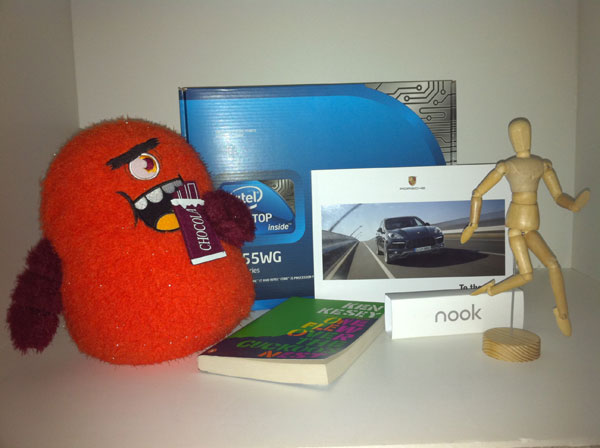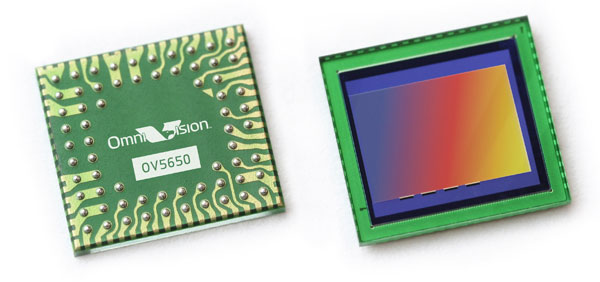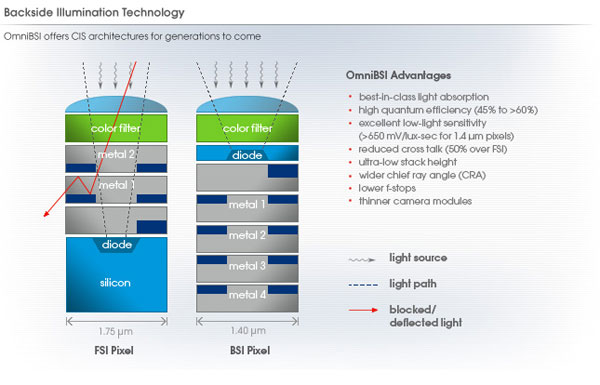Apple's iPhone 4: Thoroughly Reviewed
by Brian Klug & Anand Lal Shimpi on June 30, 2010 4:06 AM EST- Posted in
- Smartphones
- Apple
- iPhone 4
- Gadgets
- Mobile
Welcome to 2010, Apple Upgrades its Camera
The iPhone 4 is equipped with two cameras: a 5 megapixel camera with LED flash on the back of the phone and a VGA camera with no flash on the front. The LED flash works in both still and video modes. Like the EVO 4G, the iPhone 4‘s flash allows you to shoot in perfect darkness. If you’re filming a video in low light the LED will stay illuminated while you’re recording.

Taken with the iPhone 4 in total darkness
The same unfortunately can’t be said for the front facing camera on the 4. In anything but good lighting you’re going to get noise. It’s really only useful for FaceTime (or as an alternative to a mirror) and even then you need to be well lit for it to look decent.
Apple has opted for a 5 megapixel OmniVision sensor for the rear camera on the iPhone 4. What's interesting is that Apple has decided to bring backside illumination front and center with their marketing.
Backside illumination improves the sensitivity of CMOS and CCD detectors by reducing the amount of material in the path of incident light. In a frontside illuminated detector, a considerable amount of light is lost due to absorption that doesn't result in emission of an electron, in addition to reflection off pixel structures and electrical components near the frontside surface. Backside illumination greatly improves sensitivity by flipping the stack over. Instead of light having to pass through and possibly be reflected by metal structures, it is converted into electrons and read out by passing solely through silicon. Creating a backside illuminated part isn't as simple as flipping a sensor over, however, as manufacturers also generally thin the silicon light has to pass through before it can reach the photodiode. This further improves sensitivity and is generally accomplished through chemical etching in acid or by lapping (physically grinding) sensors at wafer scale.

OmniVision OV5650 - iPhone 4's rear camera SoC
Though backside illumination (BSI) improves quantum efficiency (how many photons are converted into electons), backside illumination is hugely important for another serious reason as well. Because the sensor is small at 4.6 mm by 3.4 mm, pixel size is also extremely small at just 1.75 microns square for the OV5650 in the iPhone 4 (state of the art sensors are 1.4 microns square, like those in the HTC Incredible's 8 MP sensor). Frontside illuminated parts generally have in the neighborhood of 10-15 microns of silicon before the active region of the photodiode where one wants photons to get converted to electrons. The result is that without backside illumination, pixels have a 10:1 ratio of height to length, you can visualize them as looking something like long square pillars. But that's a problem.
As photons are converted into electrons in that silicon, there's no guarantee that it will immediately travel down into the gate structure below to be read out by the camera. Electrons drift as they descend these columns, meaning that photons incident on one pixel don't necessarily map to the gate below. Because the smartphone camera sensors are so small, with a 10:1 ratio of height to size, the result is large amounts of so-called quantum blurring from electrons traveling into the gate structures of adjacent pixels. The result is a blurry image (and a decrease in MTF at the sensor level!), thus not representing the image that used to be incident on the sensor.
OmniVision and other smartphone CMOS sensor manufacturers thin that column down in an effort to come closer to having the pixel look more like a cube than a huge pillar. Ballpark numbers are between 3 and 6 microns, down from 10-15. The result is much more sensitive sensors that are higher resolution. While megapixels don't necessarily matter, neither does pixel size as much anymore; it's all about quantum efficiency, which is what engineers really care about.

OmniVision BSI - Courtesy OmniVision
The optical system of the iPhone 4 is difficult to characterize without disassembly, though the focal length is a bit shorter than previous iPhones. The result is that the photos are demonstrably wider angle. Backside illumination also allows for a bigger chief ray angle, higher numerical aperture (and thus lower f/#), but I won't bore you with the details.










270 Comments
View All Comments
Charlie22911 - Wednesday, June 30, 2010 - link
The EVO does not really bring anything new over previous highend phones like the HD2, Droid, or Nexus One aside from the front camera. Android phones are a dime a dozen.- Former Droid owner
JAS - Wednesday, June 30, 2010 - link
Had AnandTech's review concluded that the iPhone 4 is a terrible product, would you complain that the reviewers have a bias *against* Apple?I've read the review a couple times and see it as nothing but fair.
g5isalive - Wednesday, June 30, 2010 - link
I registered just to thank you for finally getting to the meat of the iPhone reception issue. Absolutely the best evaluation I have read.k.alexander - Wednesday, June 30, 2010 - link
Hear, hear! I did the same. I have not read through the full review, but the page on the antennae issue is by far the most thorough and thoughtful think I've seen from looking all over the web. Great Great Work!mczak - Wednesday, June 30, 2010 - link
Looks like a glaring omission, however I'm not convinced yet it would actually improve matters a lot. The bumper case not only insulates but also adds distance between your fingers and the antenna.I think it would be an interesting experiment to actually try this out, with some duct tape as insulative coating for instance...
btw I think that bumper case is _vastly_ overpriced. For that price I'd expect it would at least properly work with the dock connector, but as is that's not really good value...
kmmatney - Wednesday, June 30, 2010 - link
It works with an "Apple" dock connector - just not with third party connectors that make the connector too large. I'd probably just file down my cheap third party connectors before paying for an overpriced Apple accessory.MurderMostFowl - Wednesday, June 30, 2010 - link
In the signal Attenuation chart.... Is that iPhone 3GS "open palm" figure correct? 0.2 dB... I would think that kind of reception wouldn't be possible. since it is better than the other two devices by a massive amount ( remember dB is not linear )it must be an error, no?
eyk03 - Wednesday, June 30, 2010 - link
This review is just phenomenal, I love it. So much more objective and in-depth than the 27 word reviews that Walt Mossberg or David Pogue deign to fart out.spunkybart - Wednesday, June 30, 2010 - link
Finally someone sits down and does some tests!I love, love your use of the Star Trek "ugly bags of mostly water" line, lol!
I found it very interesting that your first thought was that the external antenna should have been coated -- that could have been a very easy thing to have done during manufacturing, so it sounds like Apple totally messed up on that decision!
InterHmai - Wednesday, June 30, 2010 - link
This was an incredibly well detailed review, thanks for all the hard work!